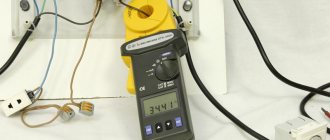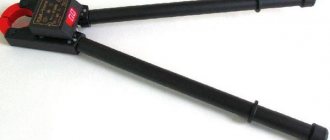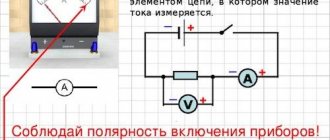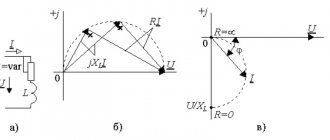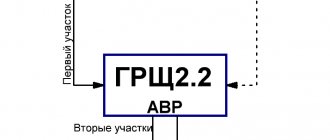The main purpose of electrical clamps
Clamp meters are mainly used to measure current in a conductor. It is the current strength in the conductor, not the cable. This feature is due to the operating principle of this device. We’ll dwell on this a little later, but now let’s look at the functionality of measuring clamps.
The functionality of this device is largely similar to a multitester, but there is one difference, which is the measurement of electric current indicators:
1.To measure the magnitude of the electric current, clamps are used, and not probes as in the tester. Thanks to this feature, there is no need to break the electrical circuit to take measurements.
2.Measurement limits – up to 1000 Amperes.
Otherwise, the use of electrical measuring tongs is identical to the use of a tester.
Main elements of measuring clamps:
- detachable measuring transformer - clamps;
- handle for opening the tongs;
- device body;
- function and range switch;
- output connectors;
- button for recording measurements.
The device switch has several measurement modes:
- alternating current - ACA;
- direct current – DCA;
- alternating voltage – ACV;
- constant voltage - DCV;
- dialing – signal icon;
- diode check – diode icon;
- resistance is the Greek letter omega.
The principle of connecting wires to connectors:
- “VΩ” connector - red wire;
- “COM” connector - black wire;
- connector "EXT" - insulation meter.
We seem to have sorted out this issue, we can move on to the next one.
Structural elements of current clamps
Electrical clamps include the following main elements:
- connectors into which the corresponding probes are connected;
- display showing the measurement result;
- mode switch;
- tool release button;
- magnetic circuit (the clamps themselves).
When measuring direct current, the device circuit includes:
- electric current transformer;
- rectification bridge.
The secondary winding is connected to the switches with a set of shunts.
Current clamps are divided into one- and two-handed. One-handed designs combine a handle and an insulating part. Opening is carried out by a push lever. The work is done with one hand.
For two-handed devices, the size of the handles exceeds 13 cm, and the insulating part is 38 cm or more. A design feature is their use with 2 hands.
When purchasing, they are determined by choosing how to choose the necessary tool. In retail outlets there is a large assortment of these devices with different functionality, which determines their price. When purchasing, the consumer must decide on the necessary functionality, some of which may be unnecessary.
The tool is mainly designed to solve the following tasks:
- measure network voltage and output amperes;
- determine the frequency of electric current;
- ring the wires.
Capabilities of clamp meters
If clamps were initially created as an addition to professional measuring instruments, then further industry opportunities for miniaturization and simplification of devices made this device relatively inexpensive and accessible to ordinary users for domestic use.
At the same time, the scope of its use is constantly growing and only standard tasks that can be performed with its help include the following items:
- Measuring the current strength in a single conductor, which is not only not disconnected from the circuit, but is also energized.
- Determination of the actual power of any electrical appliance at different times and depending on the load.
- Determination of the actual load on the entire electrical network of a house or apartment “in real time”.
- Checking the electrical network for unauthorized connections.
- Checking for current leakage on the body of the electrical appliance.
Security measures
When working with such equipment, you should adhere to the general safety rules for operating electrical measuring instruments, despite the fact that the use of current clamps is a safe procedure. It is prohibited to exceed the value of the selected electric current range and change the range during the measurement process. You should also not hold bare probes with unprotected hands that are not protected by a dielectric.
A lamp is an example of a device operating at alternating current from 220 V
Before using any device, you should carefully study the operating manual and all instructions. This helps not only not to expose yourself to danger, but also to extend the life of the device. This is very important, since the manual describes the setup of the device, its operating modes, and the principles of its safe use. Moreover, such manuals tell you how long and how to calibrate the device. It is done in specialized centers, and is needed to increase the accuracy of the measured parameters.
You may be interested in this: Working with an electrical tester
Current meter with protective handles for high voltage networks
Thus, a DC current clamp meter is a convenient and practical tool for determining the strength of electric current without breaking the wires, as is done with an ammeter or multimeter. With its help, you can measure the electric current in a car and its wiring, at home and at sites where the electrical network is laid, installed or maintained at any time.
Advantages and disadvantages
Current clamps have become widespread due to a number of advantages that determine the choice in their favor, if necessary, have a corresponding device “on hand”:
- The maximum possible simplicity, device size and measurement accuracy.
- Possibility of use for measurements in high-voltage circuits and microcurrents.
- The operating principle of pliers allows you to create devices of various designs and functionality.
- Easy integration with other electrical measuring devices. For example, current clamps combined with a multimeter have proven to be very effective - the limits of possibilities for household use for such devices are very difficult to imagine, since they can be equipped with a temperature sensor and other “goodies” that expand the functionality.
The device is extremely easy to use; its development, even on an intuitive level, is accessible to anyone who is even more or less familiar with the basics of electrical engineering.
When using electrical clamps, one must take into account some of the inherent disadvantages of such devices:
- Since the device reacts to an electromagnetic field, there is some dependence on the position of the wire inside the primary winding (ring) and its position - it is advisable to place the clamps perpendicular to the conductor being measured.
- A sensitive device can be very susceptible to interference currents that can occur when there are a large number of conductors close to what is being measured.
- The simplicity of the device design opens up wide opportunities for the production of low-quality clones of devices from reputable manufacturers. Such copies are not equipped with proper protection schemes and the accuracy of their readings leaves much to be desired.
How to measure current using a transformer
When a conductor is passed through the terminals of the device, current passes through these terminals, acting as the iron core of a power transformer. Next, the current flows into the secondary winding, which is connected through the meter input shunt. Due to the ratio of the number of secondary windings to the number of primary windings wound around the core, the current entering the input is much less. Typically, the primary winding consists of one conductor, around which the jaws are clamped. If the secondary winding has, for example, 1000 turns, then the current in the secondary winding will be 1000 times less than that flowing through the primary winding. Thus, 1 ampere in the conductor being measured will produce only 1 milliampere at the instrument input. By increasing the number of turns in the secondary winding, powerful currents can be easily measured.
How to measure direct current, because it flows through conductors with a fixed polarity? Here the magnetic field around the conductor does not change, and it is impossible to record the corresponding readings in the usual way. Therefore, the clamps around such a conductor are closed with some gap (see Figure 2).
Measurement modes
There are 2 methods for determining current strength:
- direct;
- indirect (inductive) measurement.
The first method is carried out by connecting an ammeter to an open circuit. An electric current passes through the device, information about the value of the I value appears on the display.
Advantages of this method:
- measurement accuracy depending on the class of equipment;
- ease and accessibility of measurements.
Flaws:
- it is impossible to measure large amounts of electric currents due to the design features;
- without a break it is impossible to measure the parameters of the circuit;
- measurements are performed only in the circuit that is connected to the device.
If the electrical clamp acts as a current transformer in the role of a secondary coil, then the inductive method is used.
Its advantages:
- safety;
- measurements of large values of electricity are carried out;
- there is no need to break the circuit to carry out measurements;
- mobility of measurements performed.
But it is not without its drawbacks:
- measurements cannot be performed in hard-to-reach places;
- for small values of the parameters being determined, there is a large error.
When using this tool, it is useful for an electrician to know some nuances that improve the quality of the operations performed.
When considering how to use current clamps when the value of I in the conductor is too small, which is not accurately detected by the tester, you need to use winding the conductor on one of the working parts of the device. The display shows information about the total indicator; the exact value is determined by the ratio of the obtained value to the number of turns.
If the electric current value is greater than the maximum possible for the tester, “1” appears on the screen. The range of measurements taken increases and they are repeated.
The leakage current is detected by searching for it on the grounding wire, as well as by grasping it with clamps to measure the zero and phase current. If a number other than “0” appears on the screen, then there is a leak; an insulation breakdown should be looked for on the housing.
If there is a “Hold” button, the current clamp model can measure electric current in hard-to-reach places. When performing such an action, the current clamps cover the wire, after which this button is pressed, which leads to the fixation of the value on the screen, after which it is viewed in any accessible place.
The measurement mode switch can be in different positions depending on what indicator is being measured. So, when determining direct current, it is placed in the “DCA” position, and voltage - “DCV”, for variable types - “ACA” and “ACV”, respectively. The switch also allows for continuity testing, diode and resistance testing.
The probes are connected through multi-colored connectors with different alphabetic symbols. The red wire is connected to the same connector labeled “VΩ”. The connector of the same color “EXT” is intended for connecting an insulation meter. The neutral wire is connected to a one-color connector with the symbol “COM”.
What do clamp meters measure?
Before purchasing this device, you need to decide for what purpose the electrical clamps are intended.
They are a transformer with a connected ammeter. The device itself is the primary winding of the transformer. Placing a conductor inside it helps induce an electric current into the winding due to the resulting electromagnetic field. Then it goes to the secondary winding of the coil, the readings from which are read by an ammeter. The readings of this device are recalculated adjusted for the transformation ratio indicated on it. A transformer does not work with direct current, so the current clamps described are for alternating current.
Clamp meters manufactured today are used for values measured at direct current. A Hall sensor is placed in place of the ammeter, which detects the presence and voltage of the electromagnetic field.
Using these devices, the following measurements are made:
- actual network load;
- the accuracy of readings of various equipment intended for electricity metering, comparing the readings on them with the readings obtained when measuring with clamps;
- power of household and professional electrical appliances.
Current clamps for direct current are more expensive than their counterparts for alternating current, but they are more accurate and have improved quality indicators. The tool, used in conjunction with a digital multimeter, allows the user to save the user from calculating the desired value, since the device has a built-in calculator.
Design
In current clamp meters, two main working units can be specified:
Design of pliers
- The grips contain the windings of the transformer.
- The handle contains an ammeter or other measuring device.
An electric current is induced in the transformer windings, the characteristics of which are determined by a built-in measuring device. It must be taken into account that the induced current has a different value compared to the original one. To obtain an accurate value, a recalculation is required.
Rogowski coil and its application in current clamp meters
In modern designs of the devices under consideration, there are also other sensors - voltmeters, ohmmeters - which increase the versatility of the device. In particular, clamp meter designs using a Rogowski coil are suitable for determining alternating current values if measurements are carried out in cramped conditions.
A Rogowski coil is a device consisting of a flexible helical coil with a wire that passes through the center of the coil to the other side so that both terminals are at the same end (see Figure 3). The coil should be wrapped around the conductor where the measurement will be made. The flow of alternating current in the conductor causes a voltage induction in the coil.
Figure 2. DC current measurement circuit
Figure 3. Operating principle of the Rogowski coil
Measuring with a Rogowski coil has several advantages:
- With its help, you can measure currents in a larger range of values - from 100 mA to 100 kA and even more.
- The reel itself is flexible, thin, lightweight and durable.
- Since there are no magnetic materials, Rogowski coils cannot saturate and therefore have a high ability to withstand heavy loads.
- Immune to direct current.
- Wide frequency bandwidth reaching several MHz.
The use of Rogowski coils in current clamps is also associated with a number of restrictions, for example, the mandatory presence of an external voltage source, which must be supplied to the integrator. However, the biggest disadvantage is the presence of a phase shift, which in turn depends on the position of the coil (vertical and horizontal). The positioning error cannot be compensated using the sensor, so additional Dewesoft test leads must be connected to the clamp connectors.
Current clamp design
The design of current clamps assumes the presence of:
- Detachable magnetic wire, which is made of ferrimagnetic electric steel. A coil is put on it, which represents the secondary winding;
- A reference device that can be made in analog or digital style, depending on the model and type;
You may be interested in this Metal detector for wiring
Structure of the electronic model
- Switch for the range of electric current, which is measured;
- Special handles and insulation by which a person holds the pliers when taking measurements. It is relevant for working with high-voltage networks. At low voltage levels, the dielectric properties are performed by the housing itself.
Correct and incorrect measurement
Principle of operation
If a conductor is placed between the jaws of the clamps, then a change in the current passing through it will affect the surrounding electromagnetic field. It induces a current in the windings of the transformer. Then it will be measured from the secondary winding with a built-in ammeter.
It is important to note that the resulting current value, although corresponding to that passing through the circuit, is not equal to it. The ammeter readings are adjusted taking into account the measurement coefficient of the device.
For a long time, there was an important limitation in the operation of current clamps - they were only able to work with alternating current, because a magnetic field is created only in this case.
More advanced models were created. Now, with the help of current clamps, it is possible to work not only with alternating current, but also with direct current. Currently, there are models that contain a multimeter, which, based on the data obtained, determines the required characteristics without requiring recalculation.
Modern models of current clamps are capable of solving the following problems:
- With their help, it is possible to determine the total load of the electrical network in the apartment.
- You can determine the current strength in a specific conductor that is part of an electrical circuit. The measurement can be carried out without interfering with the operation of the circuit.
- You can determine the power of any electrical appliance at the current time. If necessary, it is possible to control the measurement of this parameter over the required period of time.
- You can monitor your home electrical network for connections from unauthorized people.
- If there is a current leak on the device body, it can be determined using this tool.
The principle of action of ticks
The first current measuring instruments of this kind were a kind of transformers, to which an ordinary ammeter was connected. The clothespins themselves, which are the visible part of the device, also represent the primary winding of the transformer. When a conductor carrying current is placed in it, due to its electromagnetic field it will be induced into this winding. After this, the electric current will go to the secondary winding. Indicators will be taken from it.
The process of measuring electric current in the panel using the multifunctional device AKTAKOM - ATK-4001
Important! The first types of these devices were a simple addition to measuring instruments and helped to more conveniently fix the wire being measured.
The values that the ammeter showed had to be calculated additionally, since it was necessary to take into account the transformation ratio. One more nuance: work only with alternating current, since transformers do not work with constant values.
You may be interested in Transformer for welding
Modern current clamps can work with any type of electric current, but to measure constant values, instead of an ammeter, they use a Hall sensor, which allows them to record the electromagnetic field and its strength.
Device complete with instruction manual
How to choose the size of current clamps
Most modern versions are also capable of recording the values of such electrical circuit characteristics as voltage, frequency, power, capacitance and resistance. However, clamps can be used to detect temperature (from sensors or thermocouples) and can also be used for a quick pass/fail resistance test that can determine whether a circuit is open or closed. During the continuity test, if the circuit is closed, the instrument beeps, so there is no need to look at the display.
Selection items that must be taken into account:
- Required measuring range.
- What should be the size and configuration of the clamps/jaws.
- What protection class is required?
- What should be the measurement accuracy?
- What set of accessories does the device come with?
- Do the pliers meet safety standards for the job?
How to measure a parameter safely? Regardless of the degree of protection of the device from external hazards, it is necessary to work with pliers only in protective gloves, as shown in Figure 5.
The durability of this measuring device also depends on strict adherence to the manufacturer's instructions, as well as on the timing of periodic verification of equipment in special laboratories.
Figure 4. DT202 clamp meter operating panel
Figure 5. How to properly hold the clamp meter during measurements
An example of using clamps to measure current in a single-phase network is shown in Figure 6, and the calibration procedure is shown in Figure 7.
Figure 6. Installation of clamps for measuring parameters of a single-phase network
Figure 7. Clamp meter calibration process
If you need to purchase these measuring devices, you must contact organizations that have a license for this type of activity. Current clamp meters from certified manufacturers are a guarantee of the accuracy and quality of the device, the possibility of its timely repair or replacement.
How to use a clamp meter
If you want to measure and find out the value of electricity consumed in 220 V networks (in an apartment, house), you can calculate it using the formula:
You need to measure the power consumption load of your apartment, house or some electrical appliance. We set the range switch to position ACA 200. Open the pliers and grasp one wire from the spirit (preferably phase). After a moment, the device will show some value, for example, 8 A.
Using the formula, we calculate the power consumption:
P = 8 ⋅ 220 ⋅ 1 = 1760 W = 1.76 kW
Video on how to use current clamps:
Current clamp meters are convenient, specialized devices that allow you to quickly and easily measure current. Most devices have a button that is responsible for recording the result. This makes it easier to work in tight spaces where it is impossible to constantly monitor the device display.
Instructions for use
The use of clamps for work in situations where voltages of up to 1000 Volts are used is no different from those used in high-voltage circuits. Next, we will consider the procedure for using household current clamps.
The use of the instrument in question depends on the type of measurements being taken. Typically the procedure is performed as follows:
- It is necessary to determine in the electrical circuit which wire the readings will be taken from. We need to remember. What if you grab not one, but more wires with pliers, then the wrong result will be obtained.
- The testing device must be set to the desired measurement mode. His choice depends on the task at hand. In this case, it will be necessary to determine not only the type of measurement, but also the required scale. If there is no information about it, then choose the largest one.
- The pliers must first be opened and then grasped around the conductor. It is important to ensure that its location is perpendicular to the plane in which the pliers are located. It is desirable that the conductor be located in the center of the circuit.
- The measurement will take place automatically. The result can be seen on the device display.
If the current is too small and it is not possible to determine it, then it is recommended to wind it several times around half of the pliers. In this case, the device will measure the total current. To obtain the required value, you need to divide this value by the number of turns made.
If the display shows one, then the current exceeds the limit value of this value. To accurately determine the desired value, you need to switch to a larger range.
Classification
Such clamps can be classified according to the electrical measuring instrument used in them. In this capacity the following can be used:
- megohmmeters;
- ammeters;
- wattmeters;
- phase meters;
- ampere-voltmeters;
- multimeters.
High voltage current clamps
Of course, in everyday life the most common models are current clamps that are capable of measuring current up to 1 thousand volts. However, in industrial conditions there is often a need to study current parameters above 1000 V. It is for such situations that high-voltage current clamps were made. In essence, their design is no different from other models of these devices, but they have very high and reliable insulation to protect the person measuring from injury.
Current clamp with multimeter
This device is perhaps the most modern of all electrical appliances currently available on the market. This is like 3in1 coffee, only from the world of electricity! This small device contains a great variety of functions: in addition to basic current measurement, it is capable of obtaining data on voltage, capacitance, frequency, and resistance. In such devices, as a rule, the measurement error is minimal. They can measure current over very wide ranges. If there is a need to monitor the waveform, this device provides an analog output for connecting oscilloscopes.
Clamp multimeters
Digital current clamps
This device has a high degree of automation. This means that it is capable of determining the necessary modes itself depending on external conditions, as well as setting precise measurement limits. As a rule, they have a non-contact voltage tester and a convenient digital display with backlight function, and are manufactured in a reliable rubberized case.
Some of these devices are also capable, like the previous type, of receiving data on voltage, capacitance, frequency, resistance, temperature, duty cycle, checking diodes, and “testing” circuits. They have a “Data hold” function: you can save the obtained measurements after opening the clamps and keep a data log. They run on regular batteries and are very small in size and weight (about 200-300 grams). Ideal for electrical installation work.
Current clamps with dial indicator
Such electric pliers can rightfully be called the forefathers of all the subspecies described above. This device was the first to use the transformer principle to measure direct and alternating current. In them, instead of a convenient digital display, the data is displayed on a pointer mechanical panel, which is why they significantly lose in convenience and ease of use. However, they have a small measurement error, which is why they have not lost their popularity and competitiveness in the market in our age of digital devices.
Switch clamps
TOP 10 best clamp multimeters
PhotoNameRatingPrice
| #1 | UNI-T UT210E | ⭐ 100 / 1003 — votes |
| #2 | BSIDE ACM91 | ⭐ 99 / 1002 — votes |
| #3 | BSIDE ACM82 | ⭐ 98 / 1001 - voice |
| #4 | UT201 | ⭐ 97 / 1001 - voice |
| #5 | ANENG ST205 | ⭐ 96 / 100 |
| #6 | PROconnect P266C | ⭐ 95 / 100 |
| #7 | PHASE EM306B | ⭐ 94 / 100 |
| #8 | KVT KT 266C PROLINE | ⭐ 93 / 100 |
| #9 | MASTECH MS2030 | ⭐ 92 / 100 |
| #10 | M9912 | ⭐ 91 / 100 |
Current clamp UNI-T UT210E
Not a bad multimeter, fits comfortably in the hand and is quite accurate. They have a rubberized body, have all the necessary functions, in general the model is wonderful. As a nice bonus, the kit includes a convenient carrying case. Country of origin: China. The average cost is 3957 rubles.
Current clamp UNI-T UT210E
Types of measurements:
- constant voltage - up to 600 V;
- alternating voltage - up to 600 V;
- direct current - up to 100 A;
- alternating current - up to 100 A;
- resistance - from 200 Ohm to 20 MOhm;
- capacitance - from 2 nF to 20 μF;
- check of CU transistors - absent;
- frequency meter - absent;
- temperature sensor - missing;
- The maximum error of the device is 4% + 5 (in capacitor capacitance measurement mode).
Additional functions:
- sound verification - yes. Signal with resistance less than 10 ohms;
- diode testing - yes;
- data retention - yes;
- setting zero - yes;
- indication of overload and low battery - yes;
- screen backlight - yes;
- auto shutdown - yes. After 15 minutes of inactivity.
General characteristics:
- opening of ticks - 17 mm;
- maximum measured voltage - 600 V;
- safety standards - CAT III 300 V, CAT II 600 V;
- display bit depth - 2000;
- operating temperature range - from 0 to +40 C;
- operating air humidity - 0% - 75%;
- power supply - 2 AAA elements (3 V).
pros
- small dimensions and weight;
- auto shutdown;
- memory function for last values.
Minuses
- small opening of ticks.
BSIDE ACM91, True RMS current clamp
Quite good pliers, characterized by high measurement accuracy and ease of use. A good model for both work and home. Country of origin: China. The average cost is 2399 rubles.
BSIDE ACM91, True RMS current clamp
Types of measurements:
- constant voltage - up to 600 V;
- alternating voltage - up to 600 V;
- direct current - up to 100 A;
- alternating current - up to 100 A;
- resistance - up to 60 MOhm;
- capacity - up to 6000 µF;
- check of CU transistors - absent;
- frequency meter - up to 1 kHz;
- temperature sensor - up to 500 C.
Additional functions:
- sound alarm - yes;
- diode testing - yes;
- data retention - yes;
- phase detection function - yes;
- low battery indication - no;
- screen backlight - yes;
- auto shutdown - yes;
- automatic selection of measurement limits - yes.
General characteristics:
- maximum measured voltage 600 V;
- opening of ticks - 20 mm;
- display bit depth - 6000;
- power supply - 2 AAA elements (2 V).
pros
- many additional features;
- high measurement accuracy.
Minuses
- low quality probes.
AC current clamp BSIDE ACM82
Good pliers, easy to use, can be in demand both at work and at home. A distinctive feature is a convenient case, the presence of additional functions and fairly high accuracy. Country of origin: China. The average cost is 3255 rubles.
AC current clamp BSIDE ACM82
Types of measurements:
- constant voltage - up to 600 V;
- alternating voltage - up to 600 V;
- direct current - no;
- alternating current - up to 200 A;
- resistance - up to 60 MOhm;
- capacity - up to 6000 µF;
- check of CU transistors - absent;
- frequency meter - up to 1 kHz;
- temperature sensor from –20 to +500 C.
Additional functions:
- sound alarm - yes;
- diode testing - yes;
- data retention - yes;
- phase detection function - yes;
- low battery indication - yes;
- screen backlight - yes;
- auto shutdown - yes, after 15 minutes;
- automatic selection of measurement limits.
General characteristics:
- maximum measured voltage 600 V;
- opening of ticks - 20 mm;
- display bit depth - 6000;
- power supply - 2 AAA elements (3 V).
pros
- automatic selection of measurement limits;
- phase detection function;
- Data storage function.
Minuses
- inability to measure direct current.
UT201, digital current clamps ACA with automatic selection of the measured range
Easy-to-use pliers with a fairly high accuracy class also have the basic functions of a multimeter. Quite a good model for home use. Country of origin: China. The average cost is 2300 rubles.
UT201, digital current clamps ACA with automatic selection of the measured range
Types of measurements:
- constant voltage - up to 600 V;
- alternating voltage - up to 600 V;
- direct current - no;
- alternating current - up to 400 A;
- resistance - up to 20 MOhm;
- capacity - absent;
- check of CU transistors - absent;
- frequency meter - no;
- temperature sensor - no.
Additional functions:
- sound alarm - yes;
- diode testing - yes;
- data retention - yes;
- setting zero - no;
- indication of overload and low battery charge - no;
- screen backlight - no;
- auto shutdown - yes;
- automatic selection of measurement ranges - yes.
General characteristics:
- maximum measured voltage - 600 V;
- safety standards - CAT II 600 V, CAT III 300 V;
- operating temperature range - from 0 to +40 C;
- operating humidity - 0% - 70%;
- power supply - 2 AAA elements (3 V);
- Display resolution: 2000.
pros
- automatic selection of measurement ranges;
- memory function.
Minuses
- inability to measure direct current.
AC Current Clamp Multimeter ANENG ST205
Relatively accurate clamps for its class, complemented by a fairly functional multimeter with automatic selection of measurement modes. In general, they can be used by both a home craftsman and a professional electrician. Country of origin: China. The average cost is 1936 rubles.
AC Current Clamp Multimeter ANENG ST205
Types of measurements:
- constant voltage (U-) - up to 600 V;
- alternating voltage (U~) - up to 600 V;
- direct current (I-) - no;
- alternating current (I~) - up to 600 A;
- resistance (R) - up to 40 MOhm;
- capacitance (C) - from 4 nF to 400 μF;
- check of CU transistors - absent;
- frequency counter - up to 1 MHz;
- temperature sensor - from -30C to +1000 C.
Additional functions:
- sound alarm - yes;
- diode testing - yes;
- data retention - yes;
- setting zero - no;
- indication of overload and low battery charge - yes;
- screen backlight - yes;
- auto shutdown - no.
General characteristics:
- pliers opening - 29 mm;
- maximum measured voltage 600 V;
- power supply - 2 AAA elements (3 V);
- Display resolution: 4000.
pros
- capacitor capacitance measurement;
- frequency meter;
- memory function.
Minuses
- no DC current measurement.
Current clamp PROconnect P266C
The device is easy to use, has fairly high quality and long (about a meter) probes. Overall quite suitable for home use. Country of origin: China. The average cost is 899 rubles.
Current clamp PROconnect P266C
Types of measurements:
- constant voltage - up to 1000 V;
- alternating voltage - up to 750 V;
- direct current - no;
- alternating current - up to 1000 A;
- resistance - up to 2 MOhm;
- capacity - absent;
- checking the gain of transistors - absent;
- frequency meter - no;
- temperature sensor - from –20 to +1000 C.
Additional functions:
- sound verification - yes;
- diode check - yes;
- data retention - yes.
- setting zero - no;
- indication of overload and low battery - no;
- display backlight - no;
- display depth - 1999;
- auto shutdown - no;
- registration of max values (Max Hold) (current surge, for example when starting the engine).
General characteristics:
- maximum operating voltage 1000 V;
- power supply - 2 AAA elements (3 V).
pros
- recording current surges;
- high voltage measurement capability;
- memory function.
Minuses
- inability to measure direct current;
- limited functionality.
Current clamps FAZA EM306B
Semi-professional pliers with a small additional set of functions. In general, a pretty good model, especially considering the low cost. The measurement accuracy is quite high and in most cases this model can successfully replace the tester. Country of origin: China. The average cost is 995 rubles.
Current clamps FAZA EM306B
Types of measurements:
- constant voltage (U-) - up to 600 V;
- alternating voltage (U~) - up to 600;
- direct current (I-) - no;
- alternating current (I~) - up to 400 A;
- resistance (R) - up to 9 MOhm;
- capacity (C) - yes;
- check of CU transistors - absent;
- frequency meter - up to 400 Hz;
- temperature sensor - missing.
Additional features:
- sound verification - yes;
- diode testing - yes;
- data retention - yes;
- setting zero - absent;
- indication of overload and low battery charge - yes;
- screen backlight - absent;
- auto shutdown - no.
General characteristics:
- safety category - CAT II 600 V;
- maximum measured voltage - 600 V;
- power supply - 2 AAA elements (3 V);
- display bit depth - 2000;
pros
- relatively low cost;
- memory function.
Minuses
- inability to measure direct current;
- limited functionality.
Digital current clamp KVT KT 266C PROLINE
A good middle-class model, it has a set of basic functions, which allows you to use the device as a multimeter. The main advantage is that the pliers open quite wide, which makes it easier to grab hard-to-reach wires. Country of origin: Taiwan. The average cost is 1890 rubles.
Digital current clamp KVT KT 266C PROLINE
Types of measurements:
- constant voltage - up to 1000 V;
- AC voltage - up to 750 V;
- direct current - no;
- alternating current - up to 1000 A;
- resistance - up to 30 MOhm;
- capacity - absent;
- transistor check - absent;
- frequency meter - up to 30 kHz;
- temperature sensor - no.
Additional features:
- sound verification - yes;
- diode testing - yes;
- data retention - yes;
- phase detection function - no;
- low battery indicator - yes;
- screen backlight - yes;
- auto shutdown - no;
- automatic selection of measurement limits - no.
General characteristics:
- pliers opening - 50 mm;
- display bit depth - 2000;
- maximum operating voltage - 1000 V;
- power supply - Krona type battery (9 V).
pros
- high voltage measurement capability;
- polarity indication;
- memory function.
Minuses
- inability to measure direct current.
Current clamp MASTECH MS2030
Quite easy to use and accurate pliers. They even have some (very limited) multimeter capabilities and a function for recording readings, which is quite convenient in hard-to-reach places. Country of origin: China. The average cost is 2100 rubles.
Current clamp MASTECH MS2030
Types of measurements:
- constant voltage (U-) - up to 600 V;
- alternating voltage (U~) - up to 600 V;
- direct current (I-) - no;
- alternating current (I~) - up to 200 A;
- resistance - up to 2 KOhm;
- capacity - absent;
- check of CU transistors - absent;
- frequency meter - absent;
- temperature sensor - missing.
Additional features:
- sound verification - yes;
- diode testing - yes;
- data retention - yes;
- phase detection function - absent;
- low battery indicator - yes;
- screen backlight - absent;
- auto shutdown - absent;
- automatic selection of measurement limits - yes.
General characteristics:
- maximum measured voltage 600 V;
- pliers opening - 28 mm;
- display bit depth - 3500;
- power supply - from AAA element (4.5 V).
pros
- small sizes.
Minuses
- very limited functionality;
- no DC current measurement.
Current clamps. Current clamp measurement
Current clamps are a convenient tool for measuring current at home and in enterprises. The functionality of such devices is ensured by applying the principle. Let's look at the structure of these devices, the features of their operation and methods of application.
Purpose
Current clamps make it possible to measure the performance of direct current or without de-energizing the conductors. As a result, it becomes possible to control the current consumption and carry out the necessary installation work while the equipment is operating. This feature makes current clamps second in demand in the arsenal of electricians, immediately after the multimeter.
Design
Standard DC current clamps have the following structure:
- Magnetic terminals.
- Holder release button.
- Switch for current measurement method.
- Display.
- Probe connection elements.
- System for recording indicators in the device memory.
Features of operation
Using the device is quite simple. To begin with, the switches are set to the required position. The pliers grasp the contacts, after which the indicators are recorded.
The main difficulty in operating the device is the need to separate a separate electrical conductor. Gripping the wire with the clamps along with the zero and phase leads to a total current that flows through all the wires.
By using current clamps to hold the entire cable, ideally the electrician gets a zero reading. If, with this connection method, the device shows different values, this may indicate a leak in the circuit.
In any case, for proper operation of the measuring unit and obtaining adequate indicators, it is necessary to find a place where it is possible to separate the individual electrical conductors. Sometimes all you need to do is look into the switchboard.
Unfortunately, it is not possible to take measurements with current clamps everywhere, which is an obvious disadvantage of the device. However, this drawback is completely covered by the ability to perform measurements without breaking the circuit.
How to use current clamps: instructions
The measuring device is connected to the electrical conductor in the following sequence:
- A place is selected where it is possible for the pliers to freely grasp a single cable.
- The mode switch knob is moved to the required position. For AC mains the designation “A~” is used. With constant current, the “A-” indicator is selected. The corresponding data, indicating the choice of one mode or another, is duplicated on the display.
- The pliers opening button is pressed, after which the grips are installed perpendicular to the conductor.
- The release device is released, which closes the circuit.
- The obtained values are recorded on the display. If necessary, data can be written to the device memory.
Security measures
In order for the measurement with current clamps to take place without negative consequences both for the condition of the circuit of conductors or an electrical device, and for the health of the user, it is necessary to pay attention to some precautionary requirements.
During measurements, electrical measuring grips must be kept suspended. It is not recommended to bend over or touch the pliers while taking readings. The presence of special electrostatic gloves is welcome.
Advice
When working with electrical installations with a power of up to 10 kW, the use of remote devices or switching measurement limits with connected contacts is prohibited. To change the value, you must remove the clamps from the conductors.
You should not use current clamps on overhead line supports with voltages up to 1000 V. If there is such a need, devices specially designed for these purposes are used.
Areas of application
With the help of current clamps it becomes possible:
- Determination of the actual load on the network. To measure the indicator in single-phase networks, measurements are taken on the input wire. The obtained data in amperes is multiplied by the voltage in the electrical network and the cosine of the interphase angle.
- Measuring the power of individual electrical appliances. When such a need arises, the current strength in sections of the circuit is determined without the need to disconnect the energy consumer. The power indicator is also calculated according to the above formula.
- Checking the functionality of devices designed to measure electrical energy consumption, checking meter values with objective, actual consumption.
How to choose current clamps?
When choosing an effective means for measuring the required parameters in conductors without breaking the electrical circuit, you should determine the necessary functionality and capabilities of the device. This is, first of all, fixation of indicators of a variable or
The specific shape of the device plays a certain role. The range of operating frequencies, the accuracy of measuring indicators, and the availability of necessary and additional functionality are also important.
In general, choosing a truly useful unit allows you to compare your own financial capabilities with the tasks to be performed.
Source: https://1skidka.com/page.php?id=12946
Safety precautions when working
Interaction with any devices that come into contact with electricity requires compliance with certain safety measures. The mites in question are no exception. During active actions carried out by them, it is prohibited:
- when connecting them to live elements, touch the open connectors;
- when working under voltage, measure resistance;
- switch ranges when the conductor is in the instrument;
- exceed the maximum overload capacity of the tool for a certain range.
With professional tools in electrical installations with voltages above 1000 V, work is carried out by 2 workers: 1 with group III and 1 with group IV.
Summing up
Current clamps are a must-have tool in any electrician's arsenal. Home craftsmen may not need them, but professionals should always have them on hand.
Sources
- https://OFaze.ru/teoriya/tokoizmeritelnye-kleshhi
- https://electrikagid.ru/instrument/elektroizmeritelnye-kleshhi.html
- https://YaElectrik.ru/elektroprovodka/tokoizmeritelnye-kleshhi
- https://ProFazu.ru/provodka/instruments/tokoizmeritelnye-kleshhi.html
- https://odinelectric.ru/wiring/tools/dlya-chego-prednaznacheny-tokoizmeritelnye-kleshhi
- https://rusenergetics.ru/instrumenty/dlya-chego-prednaznacheny-elektroizmeritelnye-kleschi
- https://stroyday.ru/stroitelstvo-doma/elektroxozyajstvo/kak-vybrat-tokovye-kleshhi-top-10-luchshix-tokoizmeritelnyx-kleshhej.html
- https://zen.yandex.com/media/asutpp.ru/tokovye-klesci—samyi-poleznyi-pribor-v-elektrike-hitrosti-i-sovety-5f2420f562983b4b06067964
[collapse]
